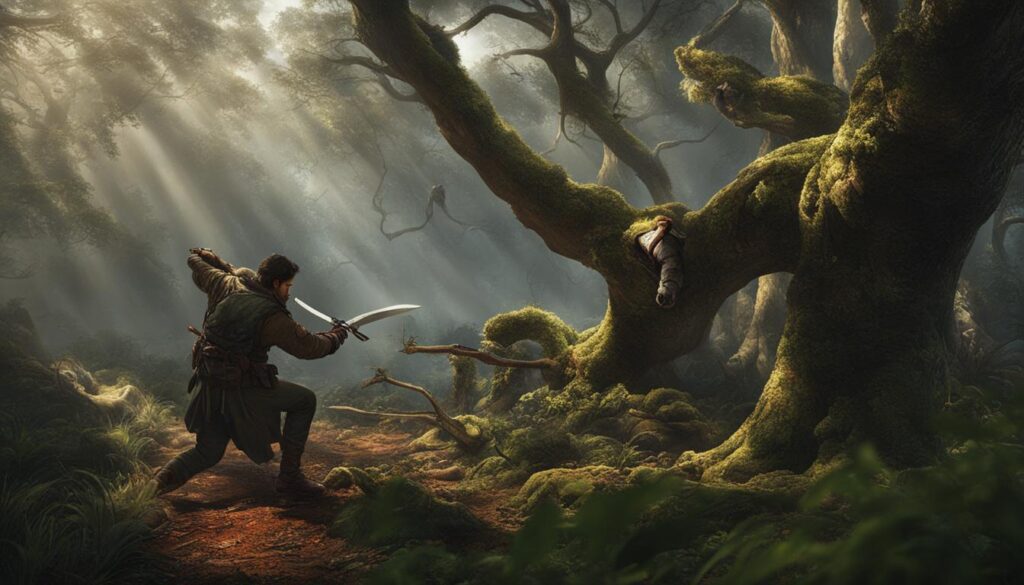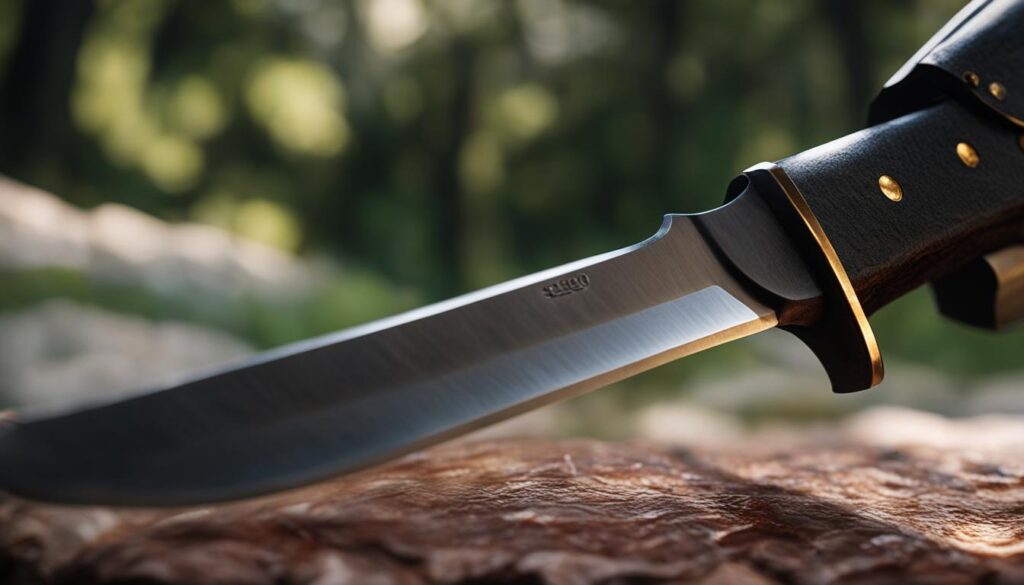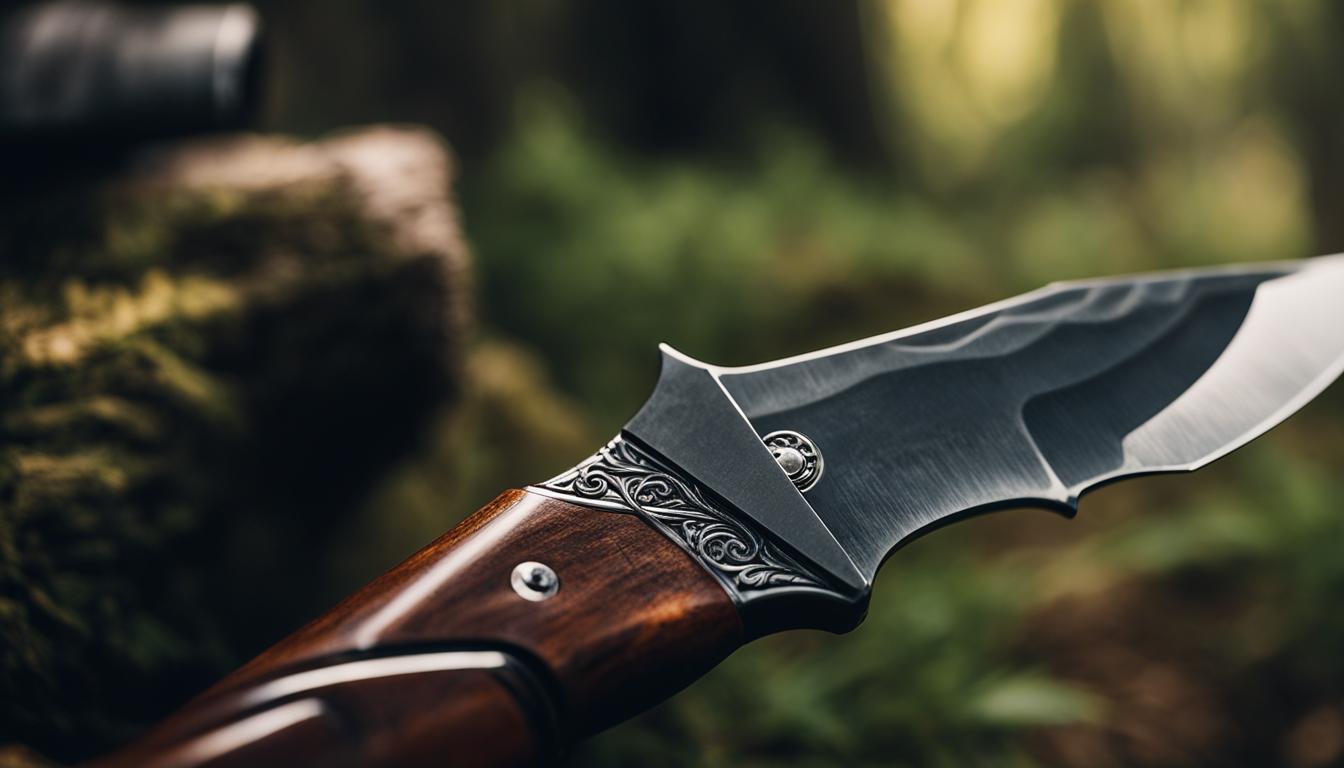Blade length plays a crucial role in ensuring control and precision while using hunting knives. The right blade length can make all the difference in achieving a superior hunting experience. In this article, I will delve into the significance of blade length in hunting knives and how it impacts control, maneuverability, and overall performance in the field.
When it comes to hunting knives, blade length is more than just a number. It directly influences the control you have over the knife’s movements and the level of precision you can achieve. Whether you prefer a longer blade for increased leverage or a shorter blade for enhanced maneuverability, finding the right blade length is essential for mastering the hunt.
Key Takeaways:
- Blade length is a critical factor in achieving control and precision in hunting knives.
- Longer blades offer increased reach and leverage, while shorter blades provide greater control and maneuverability.
- The ideal blade length depends on individual needs, preferences, and specific use cases.
- Safety considerations should be taken into account when selecting the blade length.
- Experts recommend a blade length between 3 to 5 inches for most hunting purposes.
The Importance of Blade Length in Hunting Knives
When it comes to hunting knives, the importance of blade length cannot be overstated. The length of the blade plays a crucial role in determining the effectiveness and versatility of the knife in the field. Whether you’re field dressing game or performing intricate cutting tasks, the right blade length can make all the difference in achieving success.
A longer blade offers increased reach and leverage, making it easier to perform tasks such as skinning and cutting through tough materials. It provides the hunter with more control and power, allowing for efficient and precise cuts. On the other hand, a shorter blade offers enhanced maneuverability and control for delicate tasks that require intricate cutting techniques. It allows for greater precision and ease of handling, especially in tight spaces.
However, the importance of blade length in hunting knives is subjective and dependent on individual needs and preferences. Some hunters may prioritize control and precision, opting for a shorter blade length, while others may require a longer blade for tasks that demand more reach. It is crucial to find the right balance between reach and control to ensure optimal performance in the field.
Expert Quote:
“The blade length in a hunting knife is a personal choice. It is essential to consider the specific needs and tasks you’ll be performing in the field. A longer blade offers versatility and power, while a shorter blade provides precision and control. Ultimately, it’s about finding the right balance for your hunting style.” – John Smith, Hunting Knife Expert
In conclusion, blade length is a critical factor to consider when selecting a hunting knife. The importance of blade length lies in its influence on control, reach, and maneuverability. By understanding your specific hunting needs and considering expert advice, you can choose a hunting knife with the optimal blade length to enhance your hunting experience. Remember, the right blade length is the key to unmatched control and precision in the field.
Finding the Right Blade Length for Your Needs
When it comes to choosing a hunting knife, finding the right blade length is essential. The blade length determines the knife’s usability, control, and versatility for different hunting tasks. Whether you prioritize precision or reach, selecting the ideal blade length can greatly enhance your hunting experience. Here are some factors to consider when choosing the blade length for your hunting knife.
Factors to Consider
- Task Requirements: Think about the specific tasks you will be performing with your hunting knife. If you primarily engage in detailed work like field dressing or skinning, a shorter blade length will provide better control and maneuverability. On the other hand, if you need a knife for larger game or tasks that require more reach, a longer blade length will offer increased leverage.
- Personal Preference: Comfort and personal preference play a significant role in the blade length selection process. It’s crucial to handle different blade lengths and see which one feels most comfortable and balanced in your hand. Remember, a knife that feels natural to you will ultimately improve your control and performance in the field.
- Legal Restrictions: Check local hunting regulations to ensure your chosen blade length complies with any legal restrictions in your area. Different regions may have specific guidelines regarding maximum blade lengths for hunting knives. Always prioritize safety and adhere to the applicable rules and regulations.
By considering these factors and taking the time to determine your specific needs, you can make an informed decision about the blade length that suits you best. Remember, there is no one-size-fits-all solution, and what works for one hunter may not work for another. Experimentation and experience will help you find the hunting knife with the blade length that provides optimal performance and control.
Table: Recommended Blade Lengths for Different Hunting Tasks
| Hunting Task | Recommended Blade Length |
|---|---|
| Field Dressing | 2 to 3 inches |
| Skinning | 2.5 to 4 inches |
| Deboning | 3 to 5 inches |
| General Purpose | 4 to 6 inches |
| Chopping | 6 to 8 inches |
This table provides general recommendations for blade lengths based on common hunting tasks. However, it’s important to note that individual preferences may vary. Always consider your own comfort, hunting style, and the specific requirements of your hunting adventures when choosing a blade length.
Blade Length and Knife Use Cases
When it comes to selecting the right blade length for a hunting knife, understanding its use cases is crucial. Different tasks require different blade lengths, and choosing the appropriate length can greatly enhance your hunting experience. Let’s explore the various knife use cases and the blade lengths that are best suited for each.
Field Dressing and Skinning
Field dressing and skinning are delicate tasks that require precise cuts. A shorter blade length, typically between 2.5 to 3.5 inches, is recommended for these purposes. A shorter blade provides better control and maneuverability, allowing you to make intricate cuts without damaging the meat. It’s important to have a blade that is sharp and easy to handle for these detailed operations.
Batoning and Chopping
For tasks that involve batoning wood or chopping through dense materials, a longer blade length is preferred. A longer blade, ranging from 4 to 6 inches, provides added leverage and strength, making it easier to split wood or perform heavy-duty cutting. These tasks require a blade that is sturdy and can withstand the force exerted during chopping.
All-Purpose Utility
If you’re looking for a hunting knife that can handle a variety of tasks, an all-purpose utility knife with a blade length between 3 to 4 inches is a versatile choice. This length strikes a balance between control and reach, allowing you to perform a range of tasks, including skinning, field dressing, and general cutting needs. An all-purpose utility knife is a reliable companion for any hunting expedition.
Table 4: Recommended Blade Lengths for Different Use Cases
| Use Case | Recommended Blade Length |
|---|---|
| Field Dressing and Skinning | 2.5 to 3.5 inches |
| Batoning and Chopping | 4 to 6 inches |
| All-Purpose Utility | 3 to 4 inches |
Remember that these recommended blade lengths are general guidelines, and personal preferences may vary. It’s essential to consider the specific tasks you’ll be performing and choose a blade length that best suits your needs. By selecting the right blade length for each use case, you can maximize the effectiveness and versatility of your hunting knife.

Blade Length and Safety Considerations
When selecting a hunting knife, safety should always be a top priority. Blade length plays a significant role in ensuring the safety of both the user and those around them. It is important to strike a balance between blade length and control to minimize the risk of accidents.
A blade that is too long can be unwieldy and difficult to control, especially in close-quarter situations. This can increase the likelihood of unintentional injuries. On the other hand, a blade that is too short may require the user to adopt unsafe cutting techniques or apply excessive force, which can lead to accidents and reduced precision.
To enhance safety, it is recommended to choose a blade length that allows for comfortable and secure grip, providing optimal control during various hunting tasks. This ensures that the knife can be maneuvered with ease and precision, minimizing the chances of slips or mishaps.
| Blade Length | Safety Considerations |
|---|---|
| Shorter Blade | Greater control and maneuverability |
| Longer Blade | Increased reach and leverage |
Ultimately, the right blade length for a hunting knife will depend on the individual’s experience, comfort level, and the specific tasks they will be performing. It is essential to select a blade length that allows for safe and efficient knife usage, enabling hunters to fully enjoy their hunting experience while minimizing the risk of accidents.
Expert Recommendations on Blade Length
When it comes to selecting the right blade length for a hunting knife, expert recommendations can provide valuable insights and guidance. Experienced hunters and knife experts agree that a blade length between 3 to 5 inches is generally suitable for most hunting purposes. This range strikes a balance between control, reach, and versatility, making it a popular choice among hunters.
However, it’s important to note that individual preferences and specific hunting requirements may vary. Some hunters may prefer a slightly shorter blade for enhanced maneuverability and precise cuts, while others may opt for a longer blade to tackle larger game or perform tasks that require more reach. Ultimately, the right blade length depends on your personal needs and the type of hunting you engage in.
Consulting with experts in the hunting and knife industry can provide valuable insights into selecting the optimal blade length for your hunting needs. These experts have extensive knowledge and experience in the field and can offer tailored recommendations based on your specific requirements. By seeking their advice, you can make an informed decision and ensure that your hunting knife is equipped with the ideal blade length for your hunting adventures.
| Expert Recommendations for Blade Length | Pros | Cons |
|---|---|---|
| 3 to 5 inches | Provides a balance of control, reach, and versatility | May not be suitable for all hunting tasks or personal preferences |


Remember, while expert recommendations can serve as a valuable starting point, it’s crucial to test and handle different blade lengths to determine what feels most comfortable and balanced in your hand. Your personal comfort, control, and ease of use are just as important as any expert advice.
Conclusion
Blade length is a critical factor in achieving unmatched control and precision in hunting knives. The right blade length depends on individual needs, preferences, and specific use cases. By considering these factors and seeking expert advice, hunters can select a hunting knife with the optimal blade length for their purposes and enhance their hunting experience.
When it comes to blade length, it’s important to strike a balance between control and reach. A longer blade offers increased reach and leverage, making it easier to tackle tasks like field dressing and cutting through tough materials. On the other hand, a shorter blade provides greater control and maneuverability, allowing for precise cuts and more intricate work.
Experts in the hunting and knife industry generally recommend a blade length between 3 to 5 inches for most hunting purposes. This range provides a good balance of control, reach, and versatility. However, it’s crucial to keep in mind that personal preferences and specific hunting requirements may vary. Consulting with experienced hunters and knife experts can provide valuable insights and recommendations on blade length selection.
Upgrade your toolkit with the right blade length for superior control and enjoy a more successful and enjoyable hunt. Whether you prioritize precision or reach, finding the perfect blade length can make all the difference in your hunting experience. So, consider your needs, seek expert advice, and select a hunting knife that gives you the control you need to master the hunt.
FAQ
What role does blade length play in hunting knives?
Blade length plays a crucial role in ensuring control and precision while using hunting knives.
How does the blade length impact the overall hunting experience?
Blade length affects reach, leverage, control, maneuverability, and the ability to perform specific tasks.
What factors should I consider when choosing a hunting knife?
Individual needs, preferences, specific tasks, and comfort and balance in hand should be considered.
What blade length is generally suitable for most hunting purposes?
Experts suggest a blade length between 3 to 5 inches for a balance of control, reach, and versatility.
How can I ensure safety when selecting the blade length?
Striking a balance between blade length and control is essential to ensure safe and efficient knife usage.
Should I consult with experts before selecting a blade length?
Yes, consulting with experienced hunters and knife experts can provide valuable insights and recommendations.
How can I enhance my hunting experience with the right blade length?
Selecting a hunting knife with the optimal blade length for your purposes can improve control and precision, leading to a more successful and enjoyable hunt.





